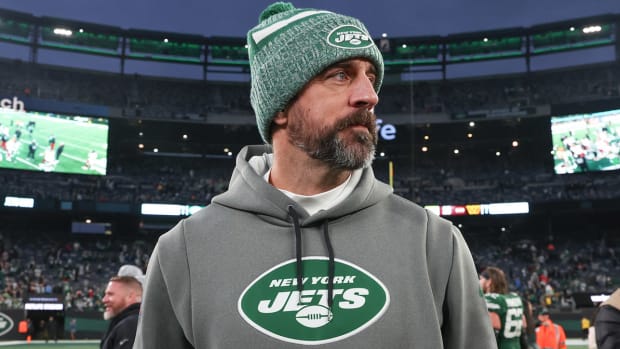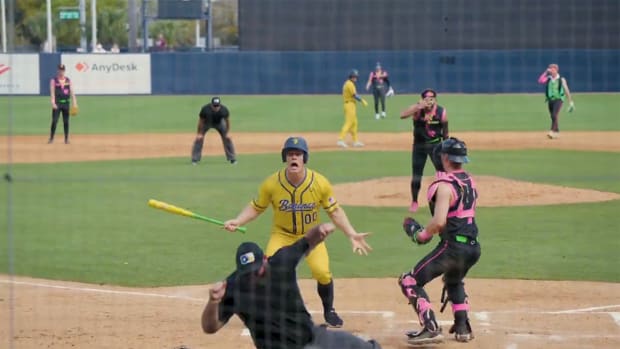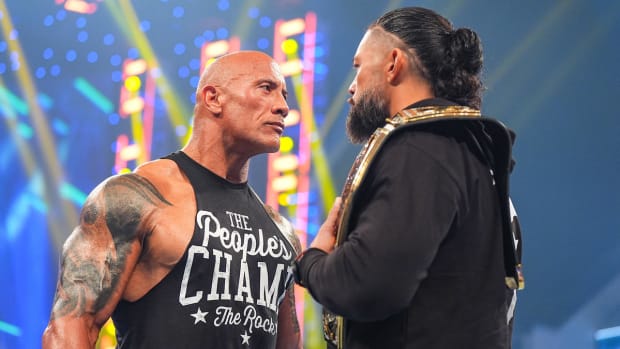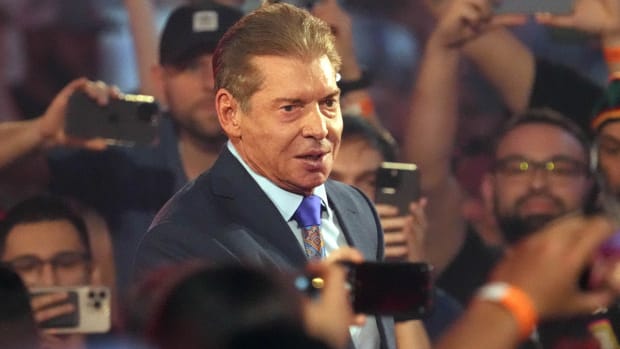AEW and WWE Controversies Show Why It Can Be Hard to Be a Wrestling Fan
SI.com’s Week in Wrestling is published every week and provides beneath-the-surface coverage of the business of pro wrestling.
AEW match restarting and WWE’s third-party edict place business of pro wrestling in unflattering light
For those that love professional wrestling, this was not the most enjoyable week.
Yes, there were highlights. WWE produced its best episode of SmackDown of the year, and though AEW’s All Out pay-per-view did not reach its high standard of excellence, there were still outstanding matches, like Thunder Rosa–Hikaru Shida and the main event of MJF–Jon Moxley.
But for many viewers, the suspension of disbelief was put on hold this past weekend by both WWE and AEW.
As first reported by Raj Giri of Wrestling Inc., WWE boss Vince McMahon informed his wrestlers that they will be expected to cease engaging with third-party video platforms like YouTube, Cameo and Twitch by Oct. 2. While McMahon’s mandate was initially positioned as a blanket ban, WWE softened its stance over the weekend, telling performers that they can continue using YouTube and Twitch as long as their channels are under their real names, Dave Meltzer of the Wrestling Observer reported. (WWE’s policy on Cameo remains unclear.) Though McMahon may be within his rights as CEO to issue the order, it causes financial harm to performers seeking to expand their stature outside of WWE and bring in additional revenue during a time when they’re losing out on money from working live events. It also raises questions about WWE’s insistence that talent are independent contractors.
The situation with AEW was entirely different, revolving around an ill-fated spot during the Matt Hardy–Sammy Guevara match at All Out. Hardy took a spear off a construction lift that was at least eight feet in the air, but he cleared the table that was supposed to take his fall, instead smacking his neck and head against the concrete floor. Hardy was noticeably hurt, and the match was stopped. Then, Hardy got back to his feet, and inexcusably, the match was restarted, putting Hardy at even greater risk.
In different ways, both stories shone a light on difficult issues in the wrestling business. It shouldn’t be this hard for wrestling fans to champion their favorite promotions.
The big issue at play with WWE is money. As Wrestlenomics’ Brandon Thurston tweeted Friday, a WWE executive mentioned during a shareholders meeting in July that the company has plans to deliver “live interactive video with our superstars,” including the possibility of “interactive fan meetings.” Cameo, which allows people to pay for personalized videos from celebrities, would clearly be a competitor if WWE decided to deliver a similar service to fans in-house.
WWE no longer wants its wrestlers to use WWE-owned names for non-WWE projects, which seems reasonable, but WWE names float in murky water. WWE’s official statement noted, “Much like Disney and Warner Bros., WWE creates, promotes, and invests in its intellectual property, i.e. the stage names of performers like The Fiend Bray Wyatt, Roman Reigns, Big E and Braun Strowman.” That statement is accurate, except it omitted that Disney and Warner Bros. characters do not work in an industry where they are encouraged to live their gimmicks and refer to themselves by a stage name.
WWE has threatened fines to those who do not comply with its new third-party restrictions, but Cameo remains unknown territory. A key piece to how this will evolve is directly related to the actions of the company’s top stars. Roman Reigns and Sasha Banks are two of WWE’s biggest superstars, and they have both remained on Cameo (as Joe “Roman Reigns” Anoai and Mercedes Motivation). AJ Styles remains on Twitch, using his ring name in on-screen graphics during his streams. The industry follows the lead of its leaders, so seeing the top talent remain on these platforms is important for wrestling as a whole.
Styles adds another interesting wrinkle to the issue. The 43-year-old Allen Jones has owned the trademark to the AJ Styles ring name since 2004, more than a decade before he signed with WWE, and retained control of it when he joined the company. WWE’s statement over the weekend alluded to protecting the company’s image. Could it force Styles to use his given name on Twitch to draw a line of demarcation between his on-screen persona and his internet presence?
For WWE, the decision to crack down on internet platforms is shortsighted. Wrestlers on sites like Twitch connect with fans in the highly sought-after 18–34 demographic, viewers WWE desperately wants to bring to the USA Network on Mondays and Fox on Fridays. Limiting wrestlers on third-party sites directly hurts the ability to connect with and reach a wider audience. There were many ways to handle this situation, but McMahon did himself no favors with the talent.
Fortunately for WWE talent, there is now a viable second option for work in AEW. But AEW had its own set of problems Saturday night at All Out.
The frightening situation with Hardy cast a shadow over the entire pay-per-view. If the roles were reversed, Vince McMahon or Paul “Triple H” Levesque would be skewered if they restarted a match after it was stopped.
Hardy’s wife, Reby, voiced her frustrations on Twitter, stating emphatically that her husband suffered a concussion. That brings up the bigger issue: Why would this match be restarted? AEW CEO Tony Khan was asked during the postshow virtual press conference whether there was even enough time to administer a proper concussion test on Hardy in that small window of time, and he stated that there was, adding that Hardy was cleared by AEW’s Dr. Michael Sampson.
How is that possible? There was no time to administer a proper concussion test. Even if he did not suffer a concussion, which Khan said he didn’t, why put Hardy in a position to hurt himself? The match ended almost as soon as it was restarted, with Hardy and Guevara climbing a light tower for a match-ending spot. At this point, the finish of a match means nothing compared with the health of Hardy.
The decision to let Hardy return to his match is a black eye that will always stick with AEW.
Wrestler safety is the foundation for a successful promotion, and AEW should use this unfortunate circumstance to tighten its policies on needless spots. Why is it necessary for wrestlers to put their livelihoods at stake in an already-dangerous business? On top of that, earlier on the show, why was Brian Cage—a very talented wrestler—allowed to put Darby Allin (another talented wrestler) in a body bag with thumbtacks and toss him over the top rope and onto the stage? I understand why Cage and Allin may find that spot appealing, but someone in a position of authority needs to step in and say that cannot happen. At the very least, if Hardy and Guevara had wrestled their match in the ring, that would have removed any concern of an unforgiving concrete floor.
Hardy is a wrestling icon and deserved better, regardless of whether he wanted to continue the match. Concussions are not broken bones that recover predictably over time. Khan tweeted that Hardy, who was taken to a hospital after the match, is healthy and will be on Wednesday’s Dynamite, but what if that match was the last time we ever saw Hardy wrestle? Would there be legal ramifications and allegations of negligence? The best-case scenario is that he is able to live a healthy life and even resume his career, but a frightening incident was made worse by the decision to allow the match to continue.
For viewers, it’s never about the wrestling. The matches are usually very good, and every week—sometimes, every night—feature compelling wrestling, which we received over the past five days. But elements away from the ring over the past week have made it more difficult to support the business behind pro wrestling.
Big E believes Xavier Woods ‘is the lifeblood of the New Day’
Xavier Woods is still recovering from an Achilles injury, but he returned to WWE programming last week to host Talking Smack.
Woods also turned 34 on Friday, which was incorporated into Big E’s story line with Sheamus on SmackDown. Even off-screen, Woods is a critical piece of the New Day’s success. Though it was Kofi Kingston who won the WWE championship at WrestleMania 35, and Big E who is now receiving a significant singles push, Woods remains the unsung hero in both of their work.
During a recent interview with Sports Illustrated, Big E also expressed Woods’s importance to the New Day and WWE.
“He’s our idea man,” says Big E. “There was a match when Kofi and I were loading someone up for our double-team finish, and Woods started playing Taps as Kofi was climbing the ropes. I don’t know if I actually broke, but all I could think was, ‘This man’s playing Taps while we’re about to finish this match.’”
Woods, who created the phenomenal UpUpDownDown gaming channel on YouTube, is one of the most creative minds in all of wrestling. The primary New Day tag team is often thought of as Big E and Kingston, and Big E explains that was a decision made by Vince McMahon out of his immense respect for Woods’s ability to enhance a match from outside the ring.
“Vince was so thoroughly entertained with the stuff Woods was doing on the floor,” says Big E. “That is why it was me and Kofi so often in the ring.”
The New Day has been together since 2014. Without a split, that six-year stretch might as well be an eternity in pro wrestling. Yet the content from the group and the partnership still feels fresh and compelling, and the insistence from Big E, Kingston and Woods to keep the New Day together has paid tremendous dividends, and Big E will be forever grateful that Woods pushed to create the group.
“Woods has brought so much life to the New Day,” says Big E. “Woods is the lifeblood of the New Day. He’s so ambitious. And let’s not forget he can also go in the ring.”
The (online) week in wrestling
- Frightening news that Dwayne “The Rock” Johnson and his family had COVID-19, but fortunately they are now in good health. AJ Styles and Kevin Nash also shared that they dealt with the virus.
- Devastating news that the extremely talented Casey Michael died last week at the age of 26. His passion for covering pro wrestling, particularly shining a light on women’s wrestling, was an inspiration, and his death is a massive loss.
- Sept. 2 marked a year since Bayley turned heel, and she added a new layer to her character with her beatdown of Sasha Banks on Friday on SmackDown. Bayley is on the short list of best heels in wrestling. If WWE can hold off Banks’s return until the Royal Rumble, followed by her winning the Rumble match, that match is a top choice for the WrestleMania 37 headliner.
- Finn Bálor is the new NXT champion, which was the best choice for the brand after Killer Kross’s injury forced him to vacate the belt. In terms of presence and ability, Bálor has few peers in wrestling, and he provides a unique feel to NXT in its battle against AEW.
- It was such a breath of fresh air to see Jey Uso win a four-way match to challenge Roman Reigns at Clash of Champions. Reigns and Heyman cut compelling promos, and adding Uso into the title picture, especially considering he is family with Reigns, is a fantastic choice.
- Not every title challenger needs to be new. Fifty-one-year-old Dustin Rhodes will challenge Brodie Lee for the TNT championship on this week’s Dynamite. Though Rhodes is a small part of a bigger story between Lee and Cody Rhodes, that match is an opportunity for Rhodes to show he is still a special talent.
- On another note, The Dark Order has added some brilliant content to Being the Elite.
- Cartoon Network Latin America announced a new animated series with Rey Mysterio. Mysterio’s son Dominik starred again this week, destroying Buddy Murphy in a street fight on Raw that ended with the entire Mysterio family popping Murphy with kendo sticks.
- If WWE can pivot and get the Money in the Bank briefcase to John Morrison, there is greater potential for a title run than with Otis. Why not simply have matches that put the contract on the line?
- And on the subject of SmackDown, a Jeff Hardy–AJ Styles–Sami Zayn triple threat for the Intercontinental title has the potential to be outstanding.
- Cedric Alexander adds a new piece to the Hurt Business. His turn on Ricochet and Apollo Crews brings a missing element to the faction of Bobby Lashley, MVP and Shelton Benjamin, which is youth. Though only 31, Alexander has more than a decade of experience in pro wrestling, and though his turn seemed rushed (the turn, explanation promo and ensuing match all took place on Raw), this is his chance for breakout stardom in WWE.
- New Japan Pro Wrestling announced the field for the G1 Climax, which includes talent who had been unable to travel to Japan, including KENTA, Jay White and Juice Robinson.
- A recent study found that last month’s Sturgis motorcycle rally, where Chris Jericho’s band Fozzy played a headlining concert, may have been responsible for as many as 250,000 coronavirus cases.
- Watching the Matt Hardy bump at All Out was enough to ruin the entire show for viewers, and I’m sure talent were affected by it, too. Leave it to Kayfabe News to add some humor to a very serious situation.
Dave Bautista offers a television recommendation amidst the pandemic
For those in need of something outside of wrestling to watch as the pandemic drags on, soon-to-be WWE Hall of Famer Dave Bautista has a recommendation.
“The first one popping in my head is The Sopranos, but one show that I really loved is Boardwalk Empire,” says Bautista, who was set to be inducted into the WWE Hall of Fame in April before the ceremony was postponed. “I actually became obsessed with Boardwalk Empire.”
Bautista, who just filmed an episode of Room 104 for HBO, noted that he enjoys the period pieces, and Boardwalk was set in the 1920s during Prohibition. Just as he has taken pride evolving from a star in pro wrestling to a versatile actor in Hollywood, Bautista enjoyed the work of Steve Buscemi, a supporting actor who starred in Boardwalk.
“I love gangster stuff. I’ll watch anything to do with that,” says Bautista. “I was doing a film in China. The only English-speaking channel was HBO, and I watched all of Boardwalk. When I started watching, with that cast, I couldn’t stop. HBO has great programming, and I’m grateful to be part of that with Room 104.”
Conrad Thompson previews this week’s edition of Something to Wrestle With Bruce Prichard
A new episode of Something to Wrestle With Bruce Prichard is set for this Friday, as Prichard and cohost Conrad Thompson discuss the career of Wayne Farris as the Honky Tonk Man.
Best known for his Intercontinental title run from June 1987 to August 1988, which still remains the longest reign with the belt, he started in the World Wrestling Federation as a babyface in the fall 1986. His career took off when he shifted to a heel and was partnered with Jimmy Hart, working a memorable WrestleMania III program with Jake “The Snake” Roberts that included a cameo from rock icon Alice Cooper.
“Bruce had the pleasure of working with Wayne before he was the Honky Tonk Man, and I want to hear him talk about the whole idea behind the character,” says Thompson. “It was an interesting gimmick, one that got real heat. People think the WWE just came up with this character, but this is a character Wayne created. Bruce will detail where Vince got involved.”
Ricky “The Dragon” Steamboat won the Intercontinental title at WrestleMania III in an epic encounter with “The Macho Man” Randy Savage, but the decision was made to have Steamboat drop the belt less than two months later after he requested time at home with his wife and newborn son. “The Natural” Butch Reed had been slated to win the title, but it was instead given to the Honky Tonk Man on a suggestion by Hulk Hogan after Reed no-showed a taping in Buffalo. Thompson will press Prichard on the fact and fiction behind that story.
“Bruce came into WWE right after WrestleMania III, coinciding with the start of the Honky Tonk Man’s run, so we’ll separate rumor and innuendo from the truth,” says Thompson. “This is a character that wouldn’t have worked any other time in wrestling, but he is a fascinating character from the ’80s. And dropping the belt at SummerSlam was a huge moment in Warrior’s build to the world title.”
The Honky Tonk Man’s most memorable feuds as champion were with Savage, Brutus “The Barber” Beefcake and the Ultimate Warrior, who he dropped the title to at SummerSlam ’88. Though he worked a program with Dusty Rhodes, and even had a shot as a color commentator, Farris never fit in the promotion after he dropped the title. He also had a brief run in World Championship Wrestling, until he was fired by president Eric Bischoff.
“Once upon a time, he had red-hot heat with fans,” says Thompson. “He was a true heel, and that’s a lost art. He wasn’t a cool bad guy, he was someone you wanted to see get beat up. His career never evolved to stay relevant, but he deserves a lot of credit for what he did in a short amount of time.”
Tweet of the Week
As it turned out, the Ric Flair–Shawn Michaels match at WrestleMania was more entertaining than Game 5 of the Celtics-Raptors series.
Justin Barrasso can be reached at JBarrasso@gmail.com. Follow him on Twitter @JustinBarrasso.




